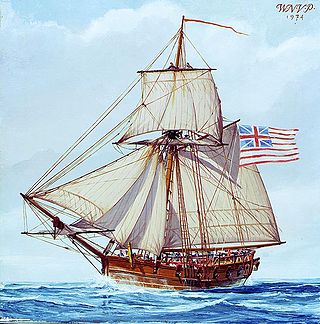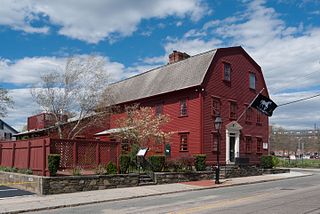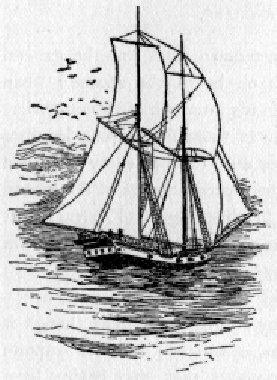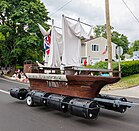
Warwick is a city in Kent County, Rhode Island, the third largest city in the state with a population of 82,823 at the 2020 census. Warwick is located approximately 12 miles (19 km) south of downtown Providence, Rhode Island, 63 miles (101 km) southwest of Boston, Massachusetts, and 171 miles (275 km) northeast of New York City.

Stephen Hopkins was a Founding Father of the United States, a governor of the Colony of Rhode Island and Providence Plantations, a chief justice of the Rhode Island Supreme Court, and a signer of the Continental Association and Declaration of Independence. He was from a prominent Rhode Island family, the grandson of William Hopkins who was a prominent colonial politician. His great-grandfather Thomas Hopkins was an original settler of Providence Plantations, sailing from England in 1635 with his cousin Benedict Arnold who became the first governor of the Rhode Island colony under the Royal Charter of 1663.

Narragansett Bay is a bay and estuary on the north side of Rhode Island Sound covering 147 square miles (380 km2), 120.5 square miles (312 km2) of which is in Rhode Island. The bay forms New England's largest estuary, which functions as an expansive natural harbor and includes a small archipelago. Small parts of the bay extend into Massachusetts.

The Colony of Rhode Island and Providence Plantations was one of the original Thirteen Colonies established on the east coast of America, bordering the Atlantic Ocean. It was founded by Roger Williams. It was an English colony from 1636 until 1707, and then a colony of Great Britain until the American Revolution in 1776, when it became the State of Rhode Island and Providence Plantations.

Commander Abraham Whipple was an American naval officer best known for his service in the Continental Navy during the Revolutionary War and being one of the founders of Marietta, Ohio. Born near Providence, Colony of Rhode Island, Whipple chose to be a seafarer early in his life and embarked on a career in the lucrative trade with the West Indies, working for Moses and John Brown. In the French and Indian War period, he became a privateersman and commanded privateer Game Cock from 1759 to 1760. In one six-month cruise, he captured 23 French ships.

John Brown was an American merchant, politician and slave trader from Providence, Rhode Island. Together with his brothers Nicholas, Joseph and Moses, John was instrumental in founding Brown University and moving it to their family's former estate in Providence.

USS Providence was a sloop-of-war in the Continental Navy, originally chartered by the Rhode Island General Assembly as Katy. The ship took part in a number of campaigns during the first half of the American Revolutionary War before being destroyed by her own crew in 1779 to prevent her falling into the hands of the British after the failed Penobscot Expedition.
HMS Sultana was a small Royal Navy schooner that patrolled the American coast from 1768 through 1772. Her role was to prevent smuggling and to collect customs duties. She was retired and sold in 1773 when unrest in Britain's American colonies required larger, better armed patrol craft.
Several ships of the Royal Navy have borne the name Gaspee :

The history of Rhode Island is an overview of the Colony of Rhode Island and Providence Plantations and the state of Rhode Island from pre-colonial times to the present.

Pawtuxet Village is a section of the New England cities of Warwick and Cranston, Rhode Island, United States. It is located at the point where the Pawtuxet River flows into the Providence River and Narragansett Bay.

Nicholas Cooke was a governor of the Colony of Rhode Island and Providence Plantations during the American Revolutionary War, and after Rhode Island became a state, he continued in this position to become the first Governor of the State of Rhode Island. Born in the maritime town of Providence, he early in life followed the sea, eventually becoming a Captain of ships. This occupation led him to become a slave trader, becoming highly successful in this endeavor, and he ran a distillery and rope-making business as well. He is depicted as one of the affluent merchants in John Greenwood's satirical painting from the 1750s entitled Sea Captains Carousing in Surinam.

The Old Colony House, also known as Old State House or Newport Colony House, is located at the east end of Washington Square in the city of Newport, Rhode Island, United States. It is a brick Georgian-style building completed in 1741, and was the meeting place for the colonial legislature. From independence in 1776 to the early 20th century, the state legislature alternated its sessions between here and the Rhode Island State House in Providence.

Joseph Wanton Sr. was a merchant and governor in the Colony of Rhode Island and Providence Plantations from 1769 to 1775. Not wanting to go to war with Britain, he has been branded as a Loyalist, but he remained neutral during the war, and he and his property were not disturbed.

Metcalf Bowler was a Rhode Island merchant, politician, and magistrate. He was for many years speaker of the house in the Rhode Island colonial assembly, attended the 1754 Albany Congress, and was elected a delegate to the 1765 Stamp Act Congress. In 1776 he was appointed to the newly independent state's supreme court. A successful Atlantic merchant, he was financially ruined by the American Revolutionary War, and was in the 20th century revealed to be a paid informant for the British Army.
Darius Sessions was a deputy governor of the Colony of Rhode Island and Providence Plantations during the buildup to the American Revolutionary War. He was heavily involved in moderating the effects of the Gaspee Affair, and was instrumental in keeping the perpetrators from being identified.

The historiography of the Gaspee affair examines the changing views of historians and scholars with regard to the burning of HMS Gaspee, a British customs schooner that ran aground while patrolling coastal waters near Newport, Rhode Island and was boarded and destroyed by colonists during the lead up to the American Revolution in 1772. Scholars agree that the incident sparked a period of renewed tension between Great Britain and its American colonies, but they disagree as to the specific long- and short-term impacts of the attack on British and colonial policies and attitudes.
John Cole (1715—1777) was a lawyer who became the 12th Chief Justice of the Rhode Island Supreme Court, serving from 1764 to 1765. Following his short tenure as Chief Justice, he became a Providence legislator, and Speaker of the Rhode Island House of Deputies. In this role he was on a committee to draft instructions to Providence citizens in regards to protesting the egregious Stamp Act passed by the British parliament to tax the American colonists. During the lead up to the American Revolutionary War Cole was privy to the plan and execution of the burning of the British revenue schooner Gaspee that ran aground near Pawtuxet, Rhode Island. He was deeply complicit with Stephen Hopkins and other leading Providence citizens in withholding evidence from the British commission of inquiry that was established to find the instigators of the Gaspee Affair. After a year of collecting testimonies, the court dissolved, having failed to indict a single person. In 1775 Cole became the Advocate General of Rhode Island's Vice Admiralty Court, but died of smallpox just two years later.

Rear Admiral William Duddingston (1740–1817) was an 18th-century Scottish commander in the Royal Navy, of fame for the Gaspee Affair, one of the precursors to the American War of Independence.

John Carter was an early American printer, newspaper publisher, and postmaster of Providence, Rhode Island. Carter entered the printing profession as an apprentice of Benjamin Franklin while living in Philadelphia. After he entered into a partnership and ran The Providence Gazette, which he eventually purchased and ran on his own up until the year of his death.



















